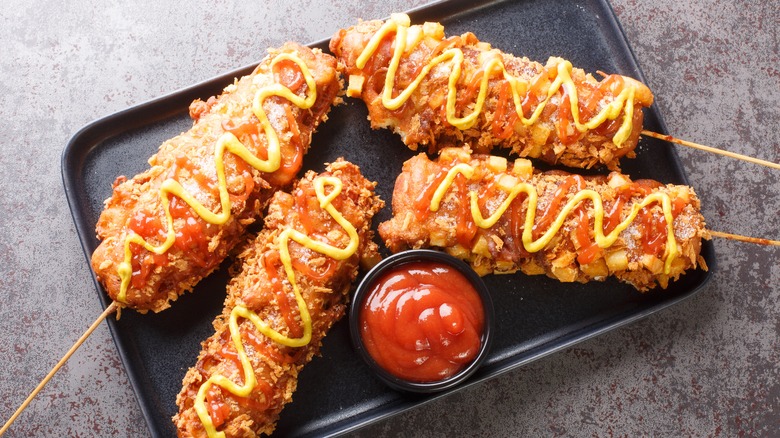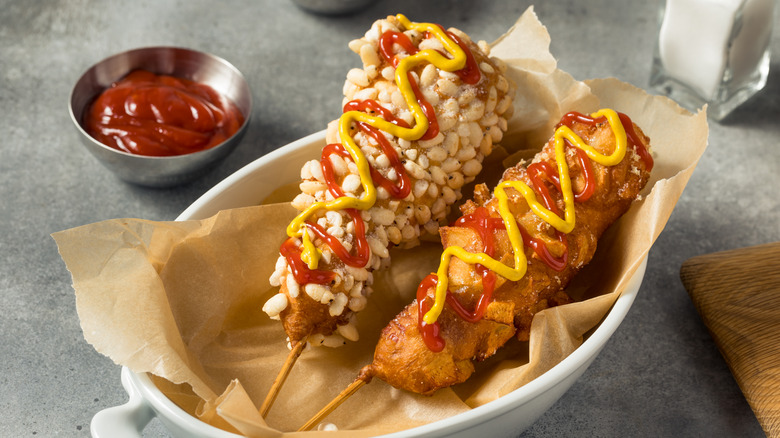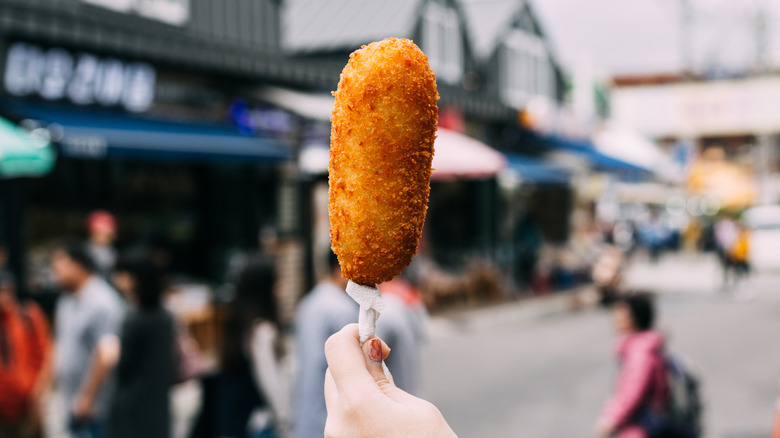How Korea Perfected The Corn Dog
For many Americans, corn dogs live in same category as other foodstuffs like hot dogs or chicken nuggets. They're simple, cheap indulgences peddled at sporting events and amusement parks. While this sentiment still holds up in some areas, corn dogs don't have this reputation everywhere, especially not in Korea.
The corn dog has long carved out a special name for itself in Korean street food culture. First gaining popularity throughout the 1980s, and slowly gaining traction ever since, it's a street vendor staple. As Korean corn dog chains such as the famous Myungrang Hot Dog slowly started opening their doors over the last decade, love for the food slowly started to spread outside of Korea and explode in popularity everywhere.
Today, Korean corn dogs are a hot commodity around the globe thanks to their extreme customizability and signature unique interplay of sweet and savory flavors. While the corn dog many Westerners know is pretty mundane, often nothing more than a sausage on a stick, Korea has really perfected the corn dog, and they're often full of surprising flavor.
What sets a Korean corn dog apart from a typical American corn dog
While the American corn dog inspired the Korean version, with American soldiers bringing the concept over to the country after World War II, there are a lot of differences between the two. For starters, while a traditional corn dog usually features a simple sausage on a stick deep fried in cornmeal batter, Korean corn dogs really stand out. These particular indulgences have sausage, mozzarella cheese, or fish cake as the base of the treat. The meat or cheese is then fried in a yeasted batter made of rice or wheat flour and then coated with panko breadcrumbs. This makes the corn dog extra crunchy and crisp rather than soft like the American version.
Still, for most, the toppings are the main event. Korean corn dogs come dusted in sweet sugar and are then rolled in anything from crushed ramen noodles to hot Cheetos. They are then finally drizzled in anything from sweet chili sauce to classic condiments like ketchup. So, while this treat might resemble a classic corn dog, they are very different treats. Still, these sweet-savory combinations are just as big of a hit too.
The rising popularity of the Korean corn dog
While the Korean corn dog may have taken off in Korea first, the treat quickly spread across Asia. As far as the West goes, for a while it was only offered as a niche choice in H-Marts. But then, thanks to social media, its popularity took hold in the States too, with its fame peaking in 2021. Now Korean corn dogs are indulged in anywhere from the county fairs of North Carolina to restaurants in Kansas. (One store in California even had to impose a limit of five corn dogs per customer in 2019 because of the intense demand.)
Some people think a big reason for the growing popularity of this dish is due to the growing presence of Korean culture in the West over the last few years. From Korean beauty products to music, knowledge of Korean culture is spreading across America and, with it, a growing desire to dive deeper into every facet of it, cuisine included. (Don't even get us started on Korean fried chicken.) Still, others say that the Korean corn dog is just another internet trend and might have the same short-lived fame in the West of other foodstuffs like TikTok's feta pasta. Well, a few years have passed since the Korean corn dog's initial rise to fame in the U.S., and it still seems to be going strong. All we know is that this treat is packed full of flavor, so we hope it sticks around.


